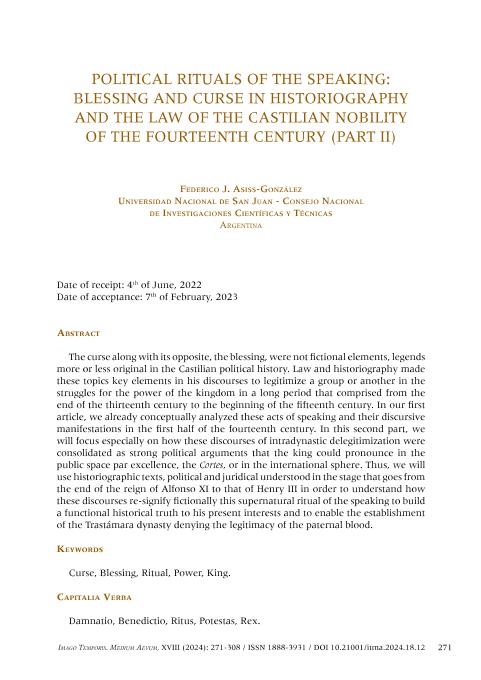Artículo
Political Rituals of the Speaking: Blessing and Curse in Historiography and the Law of the Castilian Nobility of the Fourteenth Century (Part II)
Fecha de publicación:
03/2024
Editorial:
Universitat de Lleida
Revista:
Imago Temporis
ISSN:
1888-3931
e-ISSN:
2340-7778
Idioma:
Inglés
Tipo de recurso:
Artículo publicado
Clasificación temática:
Resumen
The curse along with its opposite, the blessing, were not fictional elements, legends more or less original in the Castilian political history. Law and historiography made these topics key elements in his discourses to legitimize a group or another in the struggles for the power of the kingdom in a long period that comprised from the end of the thirteenth century to the beginning of the fifteenth century.In our first article, we already conceptually analyzed these acts of speaking and their discursive manifestations in the first half of the fourteenth century. In this second part, we will focus especially on how these discourses of intradynastic delegitimization were consolidated as strong political arguments that the king could pronounce in the public space par excellence, the Cortes, or in the international sphere. Thus, we will use historiographic texts, political and juridical understood in the stage that goes from the end of the reign of Alfonso XI to that of Enrique III in order to understand how these discourses re-signify fictionally this supernatural ritual of the speaking to build a functional historical truth to his present interests and to enable the establishment of the Trastámara dynasty denying the legitimacy of the paternal blood.
Palabras clave:
CURSE
,
BLESSING
,
RITUAL
,
POWER
,
KING
Archivos asociados
Licencia
Identificadores
Colecciones
Articulos(CCT - SAN JUAN)
Articulos de CENTRO CIENTIFICO TECNOLOGICO CONICET - SAN JUAN
Articulos de CENTRO CIENTIFICO TECNOLOGICO CONICET - SAN JUAN
Citación
Asiss González, Federico Javier; Political Rituals of the Speaking: Blessing and Curse in Historiography and the Law of the Castilian Nobility of the Fourteenth Century (Part II); Universitat de Lleida; Imago Temporis; 18; 3-2024; 271-308
Compartir
Altmétricas




